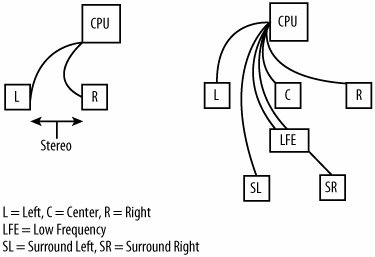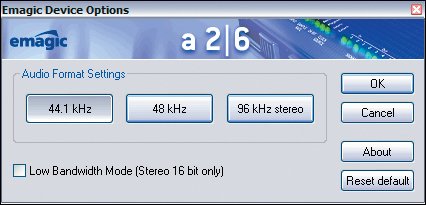Audio Interfaces
| Most base-level audio cards that come with Windows systems record in from the microphone port (usually a 1/8" stereo plug) at 16 bits, stereo at a sample rate of 44kHz. They usually play back to the speaker port (another 1/8" stereo plug) at 16 bits, stereo, 44kHz. These settings are fine for most, if not all, general usage. To capture at a higher bit depth and sample rate, however, say at 24 bits and 96kHz, then you need to invest in a more robust audio card, also called an audio interface. Capturing and working at higher rates increases the quality and detail of the sound you are recording and playing. To accurately work in and play back 5.1 surround sound audio, you will also need to add an additional audio interface. Default stereo devices have only two speaker outputs (two channels); to accurately play surround sound sequences you need an interface with six separate output channels (Figure 17.1). Because Premiere Pro supports ASIO devices, however, making the jump to a more powerful interface is quite easy. Figure 17.1. The standard stereo speaker setup (left) has a left speaker and right speaker that can connect to the default stereo output of your computer. To support six surround sound speakers (right), you need an audio interface with six output channels, each routed to the proper speaker Notes Developed by Steinberg for its VST product line, ASIO (Audio Stream Input Output) is an audio communication standard that can access one or more devices (interfaces) to record or play audio through. The benefit of the ASIO communication method is that there is an immediate response when playing or recording high-quality audio. By supporting ASIO devices, Premiere Pro assumes the features of high-quality and instantaneous audio recording and playback with a ton of professional devices (interfaces). For my laptop system, the default audio interface is the Sigma Tel-C Major Audio. For surround sound playback, I use an ASIO-certified Emagic A26 interface, which has two input ports and six output ports. If I connect the six output ports to the six speakers that make up a surround sound systemleft, center, right, surround left, surround right, and LFE (low frequency)I can properly play back from Premiere Pro in surround sound. On top of that, the device gives me the opportunity to record at a bit depth of 16 or 24 bits and a sample rate of 44, 48, or 96kHz. M-Audio has an excellent line of FireWire interfaces that support ASIO. You can use them confidently with both laptop and desktop PCs, and they are highly portable. M-Audio also has very reasonably priced surround sound ASIO PCI interfaces. If you want surround sound playback, be sure to pick up an interface with at least six output ports. In general, get a card that supports at least 16-bit, 48kHz recording and playback. Of course, 24-bit, 96kHz would be optimum. For desktop PCs, most ASIO devices will be a PCI card installed inside your machine. The back of the PCI card may feature plugs where you can insert your speaker and microphone cable or it may have a breakout box. Sometimes called a rat tail, or B.O.B, it connects to the card on one end and has female insertion points for speakers and microphones on the other. To upgrade a laptop PC, you'll need to purchase an external audio interface that connects via a USB or FireWire cable. These breakout boxes may come with various numbers of input or output ports. If you want true 5.1 support, be sure your new interface has at least six outputs. After your new audio interface is installed, you'll need to set its properties. The exact process and options depend on your card, but at a minimum you'll probably have to set the sample rate. Figure 17.2 shows the Device Options dialog for my eMagic A26. Figure 17.2. After installation, be sure to adjust the proprietary settings for your additional audio interface. Your Device Options dialog may differ from mine shown here If you are using the native supported Xena HD capture card, which supports ASIO playback, you can select it as your Audio Input and Output interface. |
EAN: 2147483647
Pages: 200

